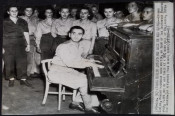Today’s Wonder of the Day was inspired by Michelle. Michelle Wonders, “How do composers write music?” Thanks for WONDERing with us, Michelle!
I’m dreaming of a White Christmas / Just like the ones I used to know . . .
It’s hard to imagine Christmas without hearing this song, “White Christmas.” In fact, “White Christmas” holds the record for best-selling single—ever! Have you ever WONDERed who wrote this song? It was Irving Berlin, a songwriter so famous that it was said that he “has no place in American music. He is American music.” Yet this man who wrote the most popular Christmas song ever, the anthem “God Bless America,” and so many other well-known songs, was once a poor Jewish refugee from Russia.
Israel Baline, who would later change his name to Irving Berlin, was born in Russia in 1888. At that time, Russia could be a dangerous place for Jewish people to live. His family’s village was burned to the ground when Israel was young. His parents wanted to leave to find a safe place to live. When he was 5, he and his family immigrated to the United States. They settled in New York City.
His family was very poor. Then, his father died when Israel was only 13. He began working and soon found that he could earn money singing on street corners. He later became a singing waiter, and in 1907 published his first song, “Marie from Sunny Italy.” He was only 19! Soon after, he changed his name to Irving Berlin. Many Jewish people in the U.S. changed their names in order to avoid experiencing antisemitism in their lives and careers.
Irving Berlin continued writing lyrics, although he could not read or write musical notation. He did not let that stop him. In 1911, he published a song that would make him famous the world over: “Alexander’s Ragtime Band.” Ragtime was a popular form of music at the time. Berlin had written dozens of songs by the end of the 1910s.
In 1912, Berlin married. Sadly, his wife died only a few months later. He wrote about his sadness in songs like “When I Lost You.” He eventually married again in 1925 and had four children. By this time, he had written many, many songs. He had also written musicals for the stage. In the late 1920s, he began to write for movies. Some of his most famous movies starred the dancers Fred Astaire and Ginger Rogers. Others starred the most well-known singers of the day, like Ethel Merman and Bing Crosby.
In 1918, while he was in the Army during World War I, Berlin had written a song called “God Bless America.” He decided not to publish it then, but saved it. Then, just before World War II, he felt that the time was right for his song. He gave the song to famous singer Kate Smith, and it became a huge success. It is still an unofficial United States anthem and is often sung at sporting events or other occasions. By then, Berlin was very successful. He donated all the proceeds from “God Bless America” to the Girl Scouts and Boy Scouts. To this day, those organizations still benefit from his donation every time the song is used!
It was just two weeks after Pearl Harbor was attacked that Berlin’s most popular song was first released. Bing Crosby sang “White Christmas” in December 1941. The song became even more well-known when it was featured in two movies, Holiday Inn in 1942 and White Christmas in 1954. It has stayed so popular, in fact, that it is the highest-selling song in history.
Berlin continued to write, eventually penning over 1,500 songs! He wrote the songs to another hit musical, Annie Get Your Gun, in 1946. He never did learn to write or read music properly, and he had a special piano made to help him play. The piano keys moved side-to-side when a lever was moved, so he didn’t have to figure out the hard process of starting a song on a different note—also known as playing in a different key! He continued to write music until the 1960s. He died in 1989, at the age of 101, in New York City, U.S.A.—as he put it, the “land that I love.”
From Ella Fitzgerald and Lena Horne to Willie Nelson and Seth MacFarlane, many performers have sung Irving Berlin’s songs. Take a listen and see—which is YOUR favorite?
Standards: CCRA.R.1, CCRA.R.2, CCRA.R.3, CCRA.R.10, CCRA.L.3, CCRA.L.4, CCRA.L.5, CCRA.L.6, CCRA.W.3, CCRA.W.4 C3.D2.His.2, C3.D2.His.3, C3.D2.Civ.10, NPES.1, NPES.5










